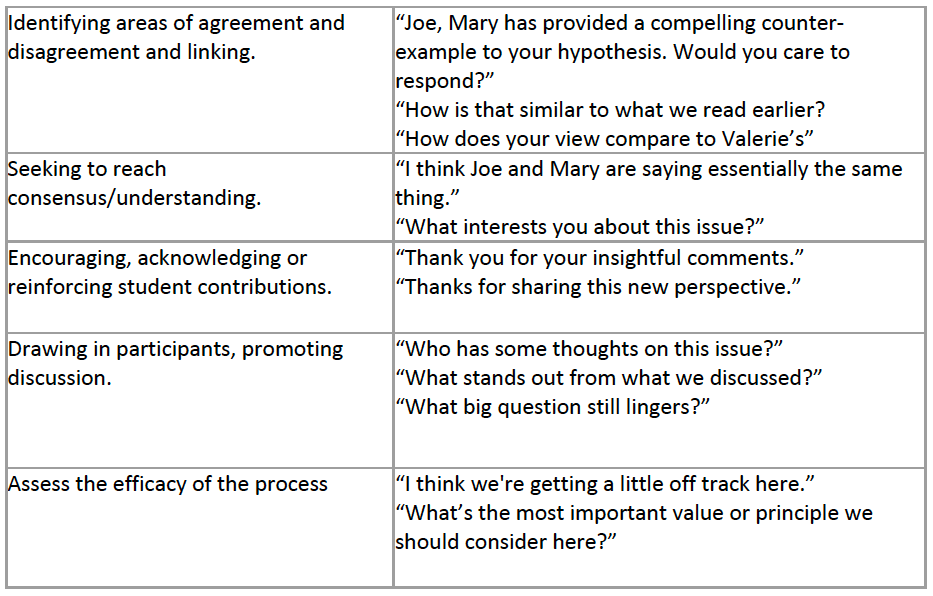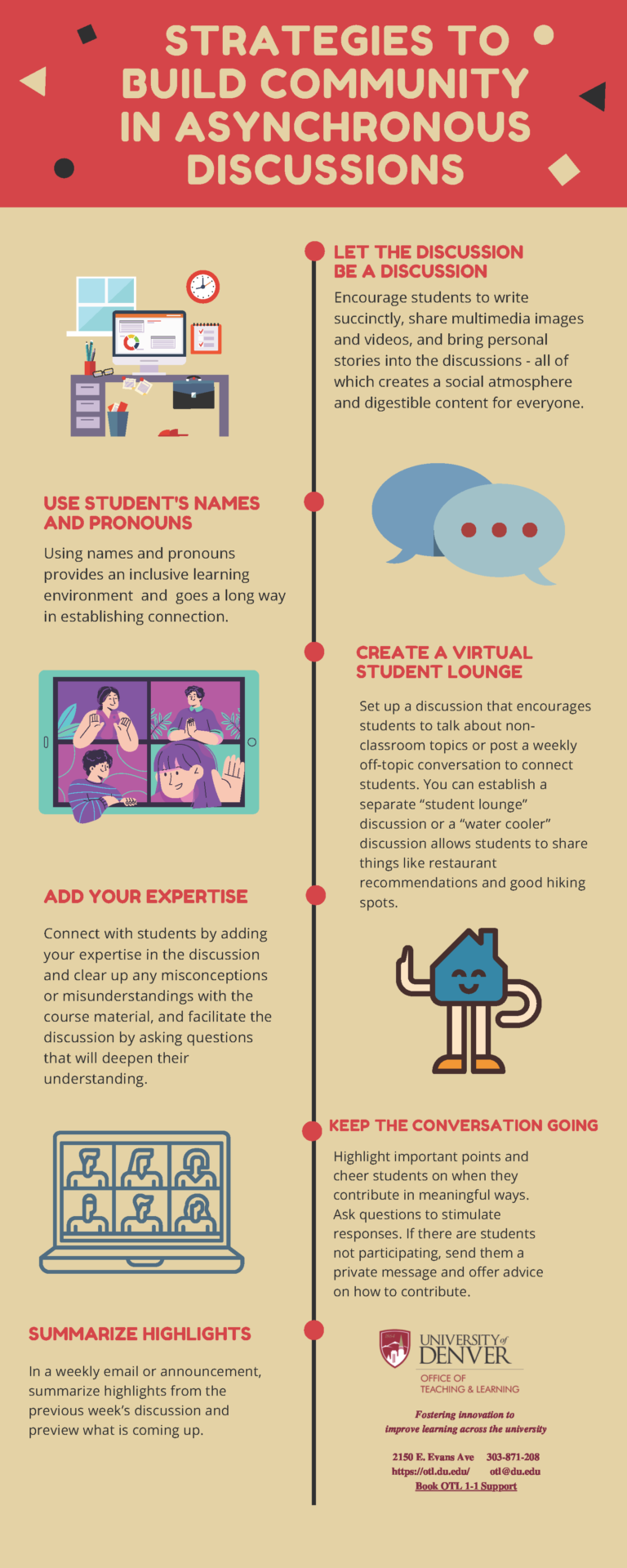By Jeff Schwarz and Vince Tango, OTL Instructional Designers
In this blog, we continue our OTL Winter Engagement Series by exploring various approaches that you can incorporate into your courses to enhance community in an online asynchronous course.
One of the most important questions faculty are asking these days is, “How can I build connection and community with my students when we aren’t face-to-face?”
Building community in an online asynchronous course can feel especially challenging, given the physical distance that separates students from each other and from their instructor. But asynchronous courses also offer unique opportunities for community building. In this post, we’ve tried to corral many of the best practices to encourage participation and, therefore, create a vital asynchronous classroom.
Asynchronous Discussions
Discussion Prompts
Discussions boards are essential for engagement in asynchronous classes. Productive discussions start with effective prompts. Ask yourself, what is the learning goal for the discussion? What is it that you want students to discuss? Here are some tips for creating an effective discussion prompt:
- Limit the number of questions or subjects to 2-3 so that students can respond thoughtfully.
- Pose questions that ask students to analyze, interpret, or synthesize material.
- Ask students to put forth their opinions based on their professional and personal experience, as a way to allow them to connect with the course subject matter.
Student Responses
It’s recommended that instructors require students to respond to one another on the discussion board. If students aren’t incentivized to respond to each other, the discussion board becomes static, a series of monologues rather than a robust conversation.
Students don’t necessarily need to respond with written posts; Canvas allows students to record audio or video posts. Students can also link to other content, such as videos, memes, and articles. These multimedia posts can make discussion boards feel more personal and dynamic.
A suggested practice is to ask students to reply to at least two of their fellow students’ posts within 48-72 hours of the initial post’s due date. Replies help put students’ at the center of the classroom discourse and encourages them to take ownership of the course and of their learning.
For additional ideas for discussion criteria, see the OTL blog post, Utilizing the Canvas Discussion Tool.
Facilitating Discussions
Facilitating a discussion online isn’t actually that different from facilitating one in a physical classroom – steer the conversation down productive avenues, ask questions, and encourage active learning by letting students engage with each other and the course material.
Online discussions are most effective when instructors participate regularly. This doesn’t mean commenting on every student post, which is time-consuming and can actually inhibit students from diving deeper into concepts. Instead, one option is to wait for students to post and then respond in the discussion by synthesizing the discussion’s ideas and posing follow-up questions for students to consider. Instructors can also comment strategically on posts that are particularly well-written or that offer engaging ideas or questions. A few comments in the discussion during the week go a long way in establishing a teaching presence.
For more ideas of how to engage with students via discussion boards, take a look at the chart below:

Video
Welcome Videos
Discussion boards, though, are just one tool for building community and fostering engagement in an asynchronous course.
The first day of class is crucial for any course, and all the more so for asynchronous courses. One of the best ways to begin building a classroom community for such courses is for the professor to create a video introduction.
You could use your video to explain your areas of research or scholarship, how long you’ve been with DU, what courses you teach, and, if you’re comfortable, your hobbies or a bit about your personal life. These videos don’t need to be (and shouldn’t be) too long; five minutes or less is a good rule of thumb. The more you make your video feel personal, the more you’ll be able to connect with your students.
As a next step, you can also encourage students to make their own videos and post them to a discussion. This allows students to begin getting to know each other as more than just names on a discussion board. If students aren’t comfortable uploading a video, they can introduce themselves with audio recordings, a written post, or in other creative ways, like making an infographic with a website like Piktochart.
Weekly Mini-Lectures
Short weekly videos are a helpful tool for students to enhance their learning and connect with you as the instructor. These mini-lectures can be used to clarify the weekly topic and highlight important points for students to consider. In addition to course content, it’s also a way to build a connection with students by offering encouragement and summarizing overall concepts where students are struggling. Weekly Announcements are a great way to leverage these mini-lectures in Canvas.
Rubrics
How instructors choose to grade and comment on student work can also play an essential role in establishing presence. Especially for discussions, rubrics can do a lot of the heavy lifting to let students know they did well and where they can improve.
Instructors can then use SpeedGrader to offer in-text comments on documents or provide written or media comments, along with submitting the grade. These strategies help students understand how their work is being evaluated, and therefore, offers them an opportunity to connect with their instructors.
Announcements and Messages
Messages to students, via emails, Canvas messages, or Announcements, are yet another way for instructors to make their presence felt. The Announcements feature on Canvas is a particularly good way to communicate with the class as a whole.
For example, instructors can use announcements to highlight compelling moments from a discussion board, or communicate with students about grades and feedback. And, like a discussion post, the Announcements feature enables the use of hyperlinks, videos, or other media. Students can also directly comment on or “like” an announcement, which can facilitate discussion.
Canvas messages are usually better-suited for individual communications. And while instructors sometimes need to reach out to students who seem to be having difficulties, it’s also a good idea to let students know when they’re doing well.
Furthermore, instructors might consider reaching out to students with a brief message around the mid-point of the quarter for an informal check in; such messages not only show students that instructors care about their success, but can also yield important information that can help an instructor make beneficial adjustments to the course.
Conclusion
The potential for asynchronous courses to build connections and support student learning depends on the active participation of both students and professors. As stated in the blog post, Engagement and Interactivity in Online Synchronous Learning, “the creative leveraging of both ed-tech tools and instructor presence can go a long way towards establishing a learning environment where students feel a sense of community and find themselves motivated to participate.” The same is true for asynchronous courses. By engaging in best practices like those listed in this post, professors can begin creating a dynamic online classroom community that is vital to maintaining interest, motivation, and engagement.
Citations
Garrison, D. R., (2017). E-learning in the 21st century: A framework for research and practice (3rd ed.). New York, NY: Routledge.




